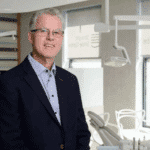For Heather Stone Hopkins, DMD, MS, maximizing the efficiencies of custom digital appliances means maximizing the practice’s entire digital workflow.
By Greg Thompson | Photography by Sean Rayford
Heather Stone Hopkins, DMD, MS, has dedicated the majority of her dozen years in orthodontics to improving treatment outcomes while introducing new efficiencies. As an owner doctor of Palmetto Smiles, a multi-specialty practice in Lexington, SC, Hopkins avidly applies her analytical mind to the advancement of orthodontic care and improved patient experience.J
Juggling a thriving practice and a growing young family, the focus on efficiency while maintaining outcomes is no mere academic exercise. For those who have only heard the buzz around “digital workflow,” but have yet to experience any true benefits, look no further. Hopkins is living proof that time spent on the front-end of technology can lead to a highly organized practice and a satisfying life.
Rotating shifts of 12-6, 8-2, and 8-5 throughout the week, Hopkins works 19 clinical hours per week. While waiting in the school car line to pick up her youngest child from kindergarten, Hopkins shared, “I designed my schedule to allow for days when I can do school drop off or pick up, and be involved in after school activities such as coaching their soccer teams. This also allows me to have admin blocks of time when needed.” Hopkins, who earned two undergrad degrees (summa cum laude) in biochemistry and molecular biology, was a starter on the soccer team, and worked a part time job while attending Centre College in Danville, Ky. She is a veteran when it comes to time management.
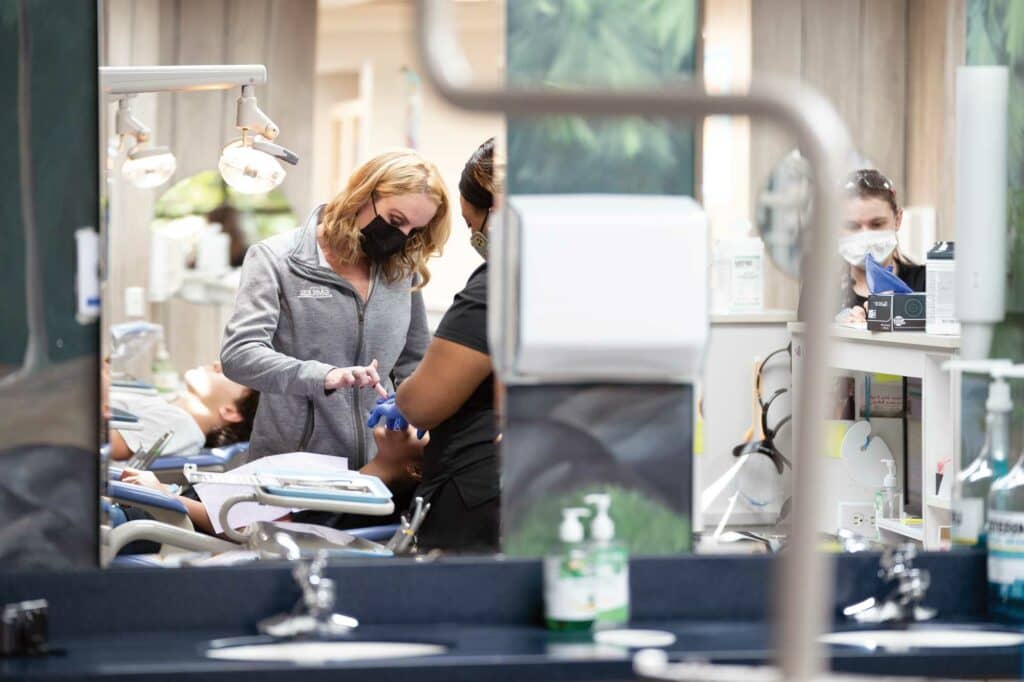
Hopkins’ 15,000-sq-ft, 38-employee practice offers general dental care, pediatric dentistry, and orthodontics. However, the true stand-out feature is that her office is 100% digital in both administrative and clinical aspects. Online scheduling, paperless forms, and two-way texting have introduced new levels of efficiency for her administrative team.
According to Hopkins, the key to her clinical efficiency is customization. By offering Invisalign clear aligners and Stride Custom Braces from KLOwen, a custom digital bracket system, every patient not only receives a custom treatment plan, but a custom appliance.
With straight wire appliances, each tooth is assigned a bracket with predetermined values. “Imagine if our mechanics were not tied to a generic set of numbers for every patient,” she says. “Clear aligners opened my eyes to how limiting the values built into our brackets can be. Based on the average instead of the individual, traditional bracket prescriptions are fundamentally inefficient.”
Not simply a user of KLOwen’s Stride Custom Braces, Hopkins had considerable input into the technology’s creation thanks to a 2012 chance meeting with KLOwen founder Brandon Owen, DDS, MS, at a lingual orthodontics meeting in France. “In the world of lingual, customization is a must,” Hopkins explains. “Brandon and I talked endlessly about customization and its advantages. At that time, most of the product offerings were overly engineered, combining custom manufacturing for every bracket with the fabrication of custom wires. The existing systems were prohibitively expensive with long manufacturing times.”
She and Owen believed a simpler custom bracket system could revolutionize clinical orthodontics. “The whole idea behind the preadjusted appliance is to not bend wire for every single tooth and every single patient,” Hopkins explains. “At the time, Andrews [inventor of straightwire/preadjusted orthodontic brackets] designed the first iterations, limitations in manufacturing, technology, and materials science didn’t allow for additional customization.”
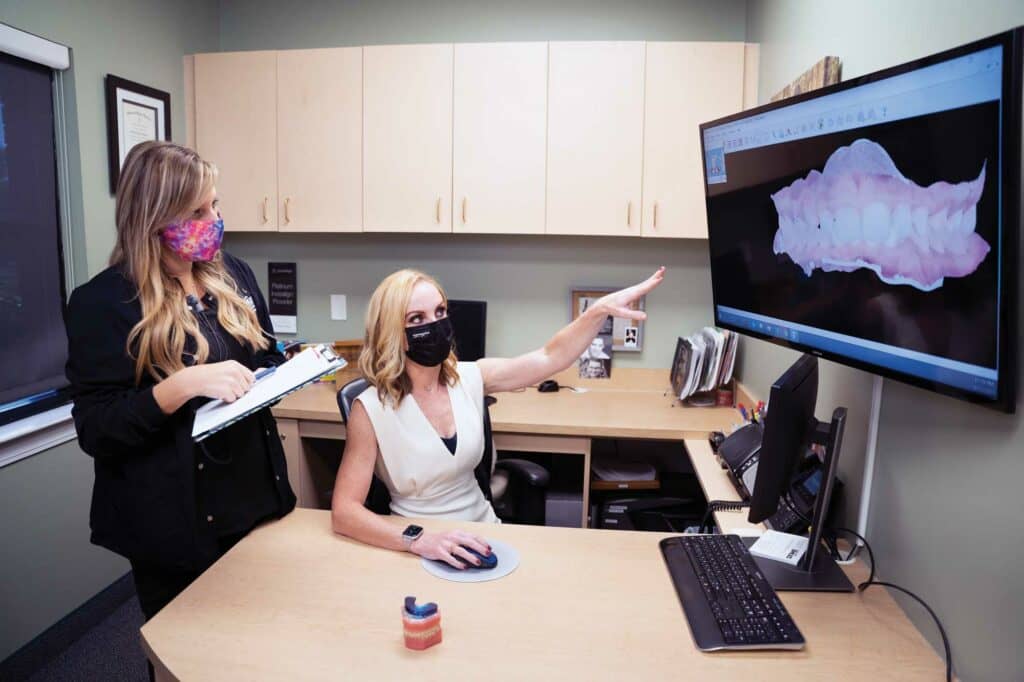
Given the advancements in these arenas over the past 40 years, Hopkins believed what Owen believed: that a better option was now possible. “What if we could blend 3D printing, CAD/CAM software, and a range of off-the-shelf brackets together to create a truly custom system?” she asked. “In 2012, the technology wasn’t quite there yet. It was several years before all the pieces fell into place to bring the concept to life.” By 2017, Hopkins was the first office in the country bonding KLOwen brackets.
The KLOwen Stride bracket library contains 27 stock brackets. These 27 brackets are sequenced by incremental changes in tip, profile, and slot angulation. The values range from -500 to + 500 for tip, 0-5mm for neck thickness, and -600 to +600 for torque. Brackets are not allotted to particular teeth.
“KLOwen and clear aligners alike cast aside concrete rules for prescription standards and bracket designation,” Hopkins explains. “In particular the KLOwen system consists of a continuum of brackets with a range of first, second, and third order values. Brackets are not pre-assigned to the same tooth for every patient.
“CAD/CAM software is utilized to create an ideal set-up of the dentition,” she continues. The software selects a best fit for each tooth from an array of 27 prefabricated options. The preferred brackets are delivered indirectly via a 3D printed tray. Merging the concepts and capabilities of a preadjusted appliance, CAD/CAM software, and 3D printing, a prefabricated custom appliance is actualized.”
Customizing orthodontic treatment chairside creates the biggest bottleneck throughout the day. Clinical assistants wait for orthodontists to come to the chair to bend wire, place brackets, or add auxiliaries. “If we can customize treatment on the front end, that’s going to clean up a lot of that bottleneck,” Hopkins says. “I am not willing to sacrifice the quality of my outcomes to scale the size of my practice. Custom appliances have allowed me to increase the number of patients we see without adding chairs, employees, or clinical hours, or sacrificing clinical outcomes.”
At first, the additional administrative work and screen time that come with custom appliances were overwhelming. Drawing upon her time management skills and systems-oriented mindset, Hopkins has made an art out of eliminating unnecessary touch points, automating scheduling, communicating with patients, and delegating case submission and tracking.
“With the way that these products work, we have a lot of information moving in the cloud,” Hopkins says. “There are a lot of steps that need to happen in between the initial exam and appliance delivery. Early on we struggled with extra appointments for our digital patients, because we had a more conventional workflow. I quickly realized how cumbersome the process was, and it didn’t make any sense when applied to custom digital appliances.”
In reimagining the initial process, Hopkins adopted intraoral scans in place of intraoral photos for new patient evaluations. “Having the 3D scan on a 52″ monitor when discussing treatment with patients has been instrumental in my practice,” she says. “The level of patient comprehension is so much higher when I can actually show them a palatal impingement or buccal crossbite as I manipulate a 3D model of their teeth on the screen. The benefits of using the 3D intraoral scan for patient education over 2D images are exponential.”
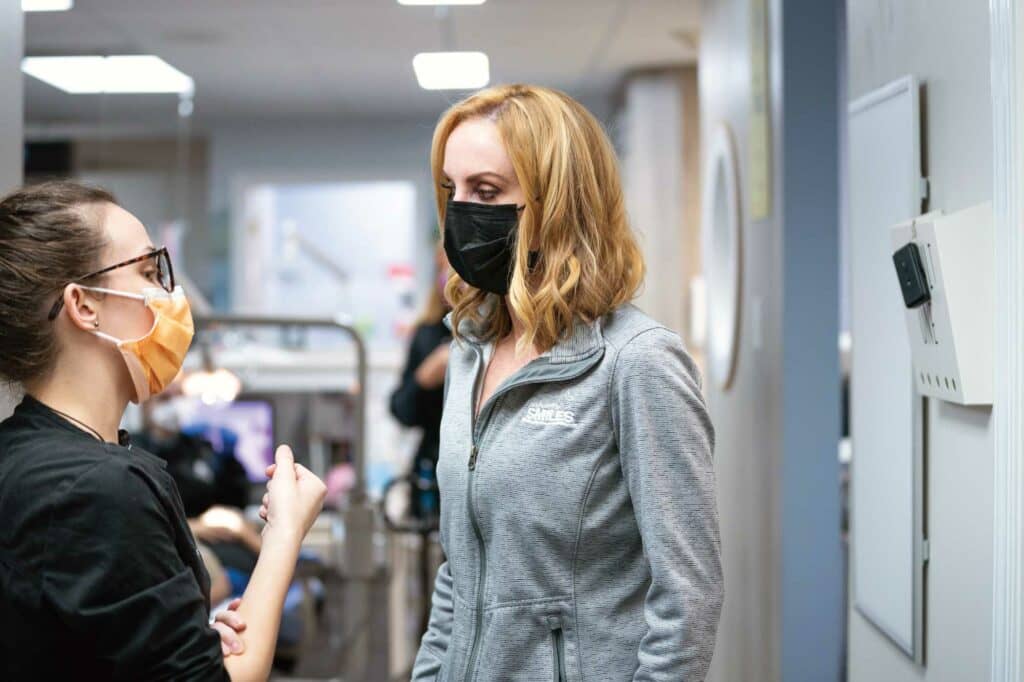
This technique has become so popular that Hopkins was approached by several companies in the industry to show how to streamline this process for doctors. Eventually, she worked with Align Technology to automate this process for any doctor with an iTero 5D intraoral scanner. “Now a composite will be auto generated by the scanner and will populate on the Invisalign Doctor Site,” she says. “My goal is to have it populate within PMS systems.”
Hopkins’ office uses software that resembles an open API (application programming interface), allowing her to integrate multiple software platforms. “I have one place I go, and it has all the information that I need,” Hopkins enthuses. “Notes from my initial evaluation, imaging, laboratory prescription information, financial information, and links to different labs are all centralized. The design includes automations and effectively delegates the entire administrative process. It allows me to focus on what I am hopefully good at and passionate about, and that is treating patients. I see patients for the eval, and then I’m notified when it’s time to work on their digital setup—but I’m no longer having to stress about any of the steps in between.”
While there is a bit of a learning curve, Hopkins is still perplexed as to why more clinicians have not transitioned fully to a digital practice. It’s been a mission of sorts to spread word of the advantages and Hopkins has been “trying to talk to practice management softwares and work on integrations with them to where it will become even more seamless.” Eventually she believes that plug-and-play solutions will be widely available which will lead to “greater adoption of custom digital treatment and a transition to digital practice models.”
As a busy mom and practice owner, Hopkins is intimately familiar with the struggle of scheduling and then shuttling kids to multiple appointments. She points out: “The systems in my office were all designed with these challenges in mind. Convenience matters, texting is easier than calling, scheduling online can be done at any hour, and virtual monitoring of custom appliances saves countless hours of missed school and work.”
When it comes to adopting new products, Hopkins thoroughly vets the technology before implementing anything practice wide. Prior to any widespread adoption, any new offering must: 1) improve outcomes for patients; 2) introduce some type of new efficiency; and/or 3) improve the patient experience.
“I’m not going to implement something because it is the shiny new toy with lots of buzz,” Hopkins says. “The wow factor is not a priority for me. I’m looking for what is going to make me a better orthodontist and improve the overall experience for everyone.”
Heather Hopkins went to college knowing that she wanted to be an orthodontist. She fell “deeply in love” with science and even considered going into a more research-based field before realizing that her personality was more suited to interacting with people than micro-pipetting samples all day. She is passionate about understanding how things work and understanding the why behind them. This passion for knowledge and love of sharing has led to her becoming an in-demand educator within the field of orthodontics.
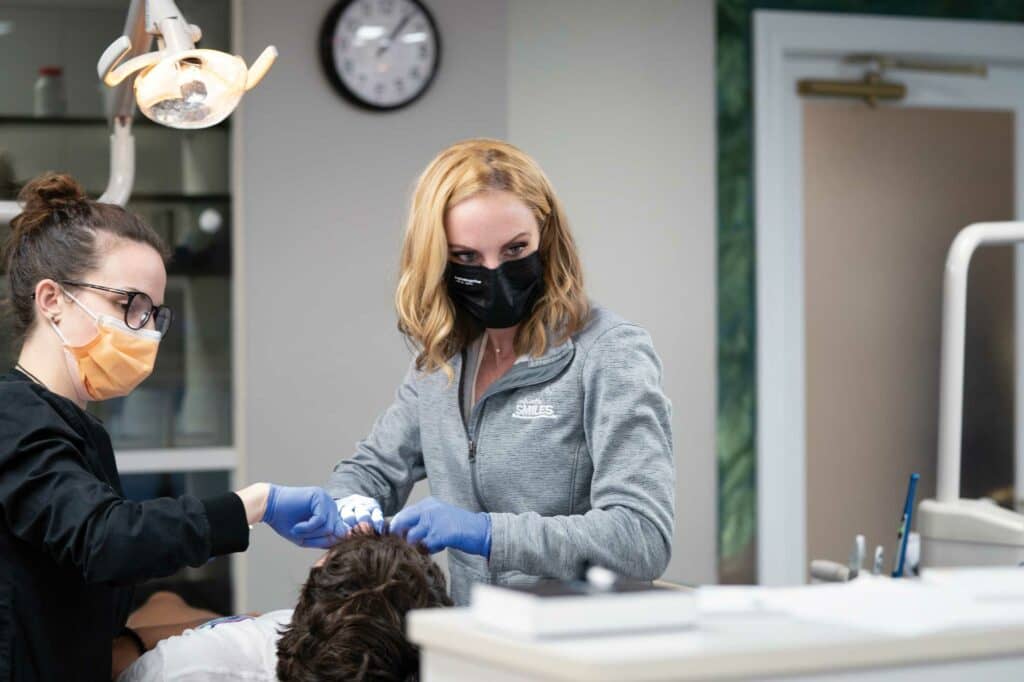
Unlike many colleagues, Hopkins never considered general dentistry and even admits with a chuckle that “I actually was very upset when I found out I had to go to dental school (University of Kentucky College of Dentistry) to be an orthodontist.” Such information wasn’t so easy to find during the pre-internet age, “and I couldn’t believe that I had to learn to do dentures and root canals.”
Despite her initial reticence, Hopkins graduated top of her class, leading to induction into the Omicron Kappa Upsilon Academic Honor Society. After dental school, she attended the University of Louisville School of Dentistry, where she earned her certificate in orthodontics and a Master’s degree in oral biology.
After seeing many parts of the South, and prior to moving to South Carolina, Hopkins had the opportunity to work in a cosmetic office in Beverly Hills when her husband, an orthopedic surgeon, moved out west for part of his training. She was recruited to work for a prominent cosmetic dentist and ended up treating major celebrities and appearing on several TV shows including: The Doctors; Extra; and MTV’s Fantasy Factory.
“It was a surreal experience,” Hopkins says. “I was suddenly on national television and treating celebrities like Jack Black, Eva Longoria, Katy Perry, and Justin Bieber. As cool as it was to close Jack’s diastema, it did not take me long to realize that they are all just people. They were all incredibly nice and cool people who happen to be in the spotlight.”
If an expanding family and a large practice were not enough, Hopkins also has an educational platform called Tipping Point Ortho where she offers online educational courses on workflow, clear aligners, and customization. It all adds up to a diverse bio that provides a healthy dose of perspective and a full appreciation for those around her who keep it all humming. “I have amazing team members, and they work really hard,” Hopkins says. “I dreamed up this whole workflow and they always buy into my visions wholeheartedly and make them come to life.”
When asked if she has any advice for the next generation of orthodontists, Hopkins replied, “Make sure you have a good support system. No one can do all of this alone. It can be a spouse, friends, family, or employees, but make sure you have good people around you. Ask for help when needed, and don’t feel guilty that you need it.” OP
Greg Thompson is a freelance writer for Orthodontic Products.







